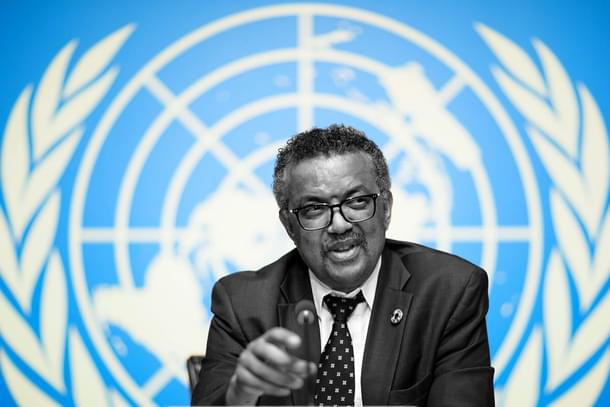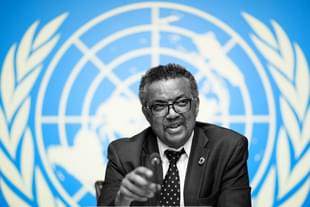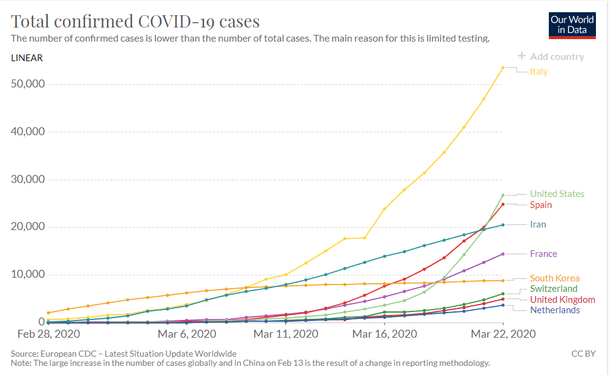World
Coronavirus Outbreak: Who Let The World Down? It’s WHO
Tushar Gupta
Mar 23, 2020, 03:15 PM | Updated 03:25 PM IST
Save & read from anywhere!
Bookmark stories for easy access on any device or the Swarajya app.


As of today (23 March), the total number of confirmed cases of Covid-19 has crossed 338,000. While more than 99,000 patients have recovered, more than 14,500 people have lost their lives to the virus.
The first epicentre for the virus was Wuhan, the capital of China’s Hubei province. On 23 January, early this year, China announced a complete lockdown in Wuhan and some other cities in the Hubei province to prevent the spread of the virus across the Chinese mainland.
Interestingly, Wuhan has not registered any new cases of Covid-19 in the last five days.
The World Health Organization (WHO) has been a global leader in the dissemination of information about Covid-19. Since 21 January, it has released a situation report each day, evaluating the spread of the virus across different parts of the world, and issuing guidelines and responsive measures for governments.
On 11 March, 48 days after the Wuhan lockdown, the WHO declared Covid-19 a pandemic, urging nations to impose emergency measures to curb the spread.
However, there are now reports surfacing that the WHO had been slow in its initial reaction to the outbreak.
According to this report in the Financial Times, the WHO was made aware of the human-to-human transmission of the virus by Taiwan at the end of December. To put things in perspective, the United States had its first Covid-19 case on 24 January, Italy on 1 February, Iran on 21 February, and Germany on 30 January.
The report adds that Taiwan has accused the WHO of failing to communicate to its member countries critical information about the human transmission of the virus and thus slowing down the response to the pandemic. It must be noted that all countries with more than 3,000 cases of Covid-19, as of today (23 March), have shown an exponential increase in the number of cases.
Taiwan, however, is not an independent member state of the WHO, as its territory is claimed by the Chinese. The report further adds that Taiwan had heard from the doctors in the Chinese mainland that due to the medical staff getting ill while treating patients, clear signs of human transmission had been established.
Further, the same information was also shared with the Chinese health authorities and the International Health Regulations (IHR). The IHR is a framework under the WHO for the exchange and communication of epidemic prevention and response data between 196 countries.
The same information, however, was not shared with any other country. WHO, unable to obtain first-hand information about the human transmission capability of the virus, was slow to react to the problem.
On 20 January, merely three days before the Wuhan lockdown, the Chinese first confirmed the human-to-human transmission potential of the virus. On 23 January, a statement from the IHR declared that the extent of the human transmission was still not clear.
However, on 14 January, a week before the Chinese admission, WHO put out a tweet saying that they had found no clear evidence of the human transmission of the novel coronavirus.
On 14 February, the WHO further defended the Chinese over the outbreak, stating that the nation had cooperated on various fronts to curb the outbreak as the US accused China of a lack of transparency.
The lack of clarity continued for another month. On 17 February, the WHO stated that the transmission of the virus was beginning to slow down, citing that much of the spread was still in China. This was one of the primary reasons that the outbreak wasn’t declared a pandemic then. At that point, only 694 cases were reported outside China.
On 25 February, in a briefing to the media, Director-General Tedros Adhanom Ghebreyesus was quoted, “for the moment, we’re not witnessing the uncontained global spread of this virus, and we’re not witnessing large-scale severe disease or deaths”.
This statement came after the WHO mission’s visit to China that had already established the peak of the spread between 23 January and 2 February.
On 29 February, in its recommendations for international air traffic in relation to the Covid-19 outbreak, the WHO made some startling remarks. By this time, China had more than 79,000 cases, and a total of more than 85,000 cases were reported across the world.
In its recommendation, the WHO stated that it advised against the application of travel and trade restrictions to countries experiencing Covid-19 outbreaks.
In its statement, the WHO declared that evidence showed that restricting the movement of people and goods during public health emergencies is ineffective in most situations and may divert resources from other interventions.
Furthermore, restrictions may interrupt much-needed aid, and a lack of technical support may disrupt businesses and may have negative social and economic effects on the affected countries.
The statement further added,
Travel bans to affected areas or denial of entry to passengers coming from affected areas are usually not effective in preventing the importation of cases but may have a significant economic and social impact. Since WHO declaration of a public health emergency of international concern in relation to COVID-19, and as of 27 February, 38 countries have reported to WHO additional health measures that significantly interfere with international traffic in relation to travel to and from China or other countries, ranging from denial of entry of passengers, visa restrictions or quarantine for returning travellers. Several countries that denied entry of travellers or who have suspended flights to and from China or other affected countries, are now reporting cases of COVID-19.
While the statement urged countries to be prepared for an outbreak, it, ironically, advised against the application of air restrictions, one of the major reasons for the global outbreak of the pandemic, especially in Italy.
Starting from Taiwan’s briefing to the WHO to their statement on 29 February, the WHO did not exhibit any clarity on the situation, thus further worsening the situation.

In retrospect, if a clear indication had come from the WHO by the end of February, the United States, the United Kingdom, France, Germany, Switzerland, The Netherlands and Spain may have been in a better position to curb the outbreak as all these nations witnessed an exponential increase in the number of cases in the initial days of March.
Today, the US is being touted as the next epicentre of the outbreak, and New York being feared as the next Wuhan.
Who let the world down?
It’s WHO.
Tushar is a senior-sub-editor at Swarajya. He tweets at @Tushar15_




